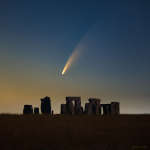
|
You entered: Stonehenge
 Nabta: Older than Stonehenge
Nabta: Older than Stonehenge
8.04.1998
In the Sahara Desert in Egypt lie the oldest known astronomically aligned stones in the world: Nabta. Over one thousand years before the creation of Stonehenge, local herders built a stone circle and other structures on the shoreline of a lake that has long since dried up.
 Stonehenge: Ancient Monument to the Sun
Stonehenge: Ancient Monument to the Sun
17.12.1997
Stonehenge consists of large carved stones assembled about 4000 years ago. Long before modern England was established, ancient inhabitants somehow moved 25 ton rocks nearly 20 miles to complete it. From similar constructs...
 Stonehenge: Ancient Monument to the Sun
Stonehenge: Ancient Monument to the Sun
12.09.1999
Stonehenge consists of large carved stones assembled about 4000 years ago. Long before modern England was established, ancient inhabitants somehow moved 25 ton rocks nearly 20 miles to complete it. From similar constructs...
 Sunrise Solstice at Stonehenge
Sunrise Solstice at Stonehenge
21.06.2010
Today the Sun reaches its northernmost point in planet Earth's sky. Called a solstice, the date traditionally marks a change of seasons -- from spring to summer in Earth's Northern Hemisphere and from fall to winter in Earth's Southern Hemisphere.
 Sunrise Solstice over Stonehenge
Sunrise Solstice over Stonehenge
20.06.2016
Today the Sun reaches its northernmost point in planet Earth's sky. Called a solstice, the date traditionally marks a change of seasons -- from spring to summer in Earth's Northern Hemisphere and from fall to winter in Earth's Southern Hemisphere.
 Planets Over Stonehenge
Planets Over Stonehenge
9.05.2002
Stonehenge, four thousand year old monument to the Sun, provides an appropiate setting for this delightful snapshot of the Sun's children gathering in planet Earth's sky. While the massive stone structure dates from around 2000 B.C.
 Sunrise Solstice over Stonehenge
Sunrise Solstice over Stonehenge
20.06.2021
Today the Sun reaches its northernmost point in planet Earth's sky. Called a solstice, many cultures mark this date as a change of seasons -- from spring to summer in Earth's Northern Hemisphere and from fall to winter in Earth's Southern Hemisphere.
 APOD: 2024 August 12 Б Perseid Meteors over Stonehenge
APOD: 2024 August 12 Б Perseid Meteors over Stonehenge
12.08.2024
What's happening in the sky above Stonehenge? A meteor shower: specifically, the Perseid meteor shower. A few nights ago, after the sky darkened, many images of meteors from this year's Perseids were captured separately and merged into a single frame.
 Sunrise Solstice at Stonehenge
Sunrise Solstice at Stonehenge
21.06.2006
Today the Sun reaches its northernmost point in the planet Earth's sky. Called a solstice, the date traditionally marks a change of seasons -- from spring to summer in Earth's Northern Hemisphere and from fall to winter in Earth's Southern Hemisphere. Pictured above is the 2005 Summer Solstice celebration at Stonehenge in England.
 Comet NEOWISE over Stonehenge
Comet NEOWISE over Stonehenge
14.07.2020
Have you ever seen a comet? Tonight -- and likely the next few nights -- should be a good chance. Go outside just at sunset and look to your northwest. The lower your horizon, the better. Binoculars may help, but if your sky is cloudless and dark, all you should need is your unaided eyes and patience.
|
January February March April May June July |
|||||||||||||||||||||||||||||||||||||||||||||||||